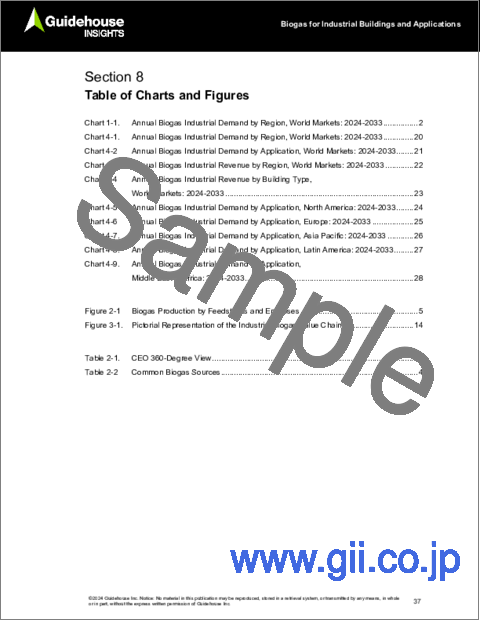|
|
市場調査レポート
商品コード
1576914
産業用建物および産業用途のためのバイオガスBiogas for Industrial Buildings and Applications: Capacity Demand and Revenue Forecasts by World Region, Application, and Building Type, 2024-2033 |
||||||
|
|||||||
| 産業用建物および産業用途のためのバイオガス |
|
出版日: 2024年10月24日
発行: Guidehouse Research
ページ情報: 英文 39 Pages; 44 Tables, Charts & Figures
納期: 即納可能
|
全表示
- 概要
- 目次
バイオガスは、燃料を燃焼させなければ困難な産業活動の脱炭素化に大きく貢献すると期待されていますが、これまでのところ市場開拓には大きな障壁があります。炭素価格が上昇し、再生可能なパイプライン・ガスの義務化が進むにつれ、バイオガスと再生可能天然ガス(RNG)の需要は加速するとみられています。今日、世界中で産業用途に使用するために生成されるバイオガスのうち、およそ3分の2がRNGに変換されています。埋立地や廃水処理場などの自治体施設と農業経営が、産業用バイオガスの最大の発生源ですが、それぞれの発生源の重要性は地域によって大きく異なります。
今日、産業用バイオガスの分野で最大の原動力となっているのは、バイオガス開発に対する財政的インセンティブや排出レベルの規制を含む政府の政策です。その他の促進要因としては、特定の地域における豊富で適切な原料や、企業の脱炭素化目標などがあります。しかし、産業用バイオガス市場は大きな逆風にも直面しています。最も顕著なのは、多くの場所でバイオガスやRNGが化石ガスの4~6倍の価格になっていることです。その他の障壁としては、バイオガスをRNGにアップグレードするための多大な追加コストや、特定の用途のためのバイオガス生成にのみインセンティブを与える政策のタテ割りなどがあります。
当レポートは、産業用建物および産業用途のためのバイオガス市場について調査し、現在の市場の課題、技術動向、市場促進要因、障壁、政策状況などを分析しています。また、収益と販売台数の市場予測も掲載しています。
目次
第1章 エグゼクティブサマリー
第2章 市場の問題
- イントロダクション
- ガスの種類
- 産業用途
- 政策
- 促進要因
- 抑制要因
- 価格
第3章 産業バリューチェーン
- 競合情勢
- M&A活動
- ビジネスモデルの進化
第4章 市場予測
- 調査手法
- 定義と範囲
- 世界の予測
- 地域別予測
- 北米
- 欧州
- アジア太平洋
- ラテンアメリカ
- 中東・アフリカ
第5章 結論・提言
第6章 頭字語と略語一覧
第7章 目次
第8章 図表
第9章 調査範囲、情報源と調査手法、注釈
Biogas holds significant promise for helping to decarbonize industrial activities that are difficult to conduct without fuel combustion, though substantial barriers have thus far limited market development. As carbon prices rise and mandates continue to emerge around renewable pipeline gas, demand for biogas and renewable natural gas (RNG) will likely accelerate. Of the biogas generated globally for use in industrial applications today, roughly two-thirds is converted into RNG. Municipal facilities, such as landfills and wastewater treatment sites, and agricultural operations are the largest generators of industrial biogas, though the prominence of each source varies significantly by geographic region.
By far, the largest driver in the industrial biogas space today is government policy, including financial incentives for biogas development and regulation on emissions levels. Other drivers include an abundance of suitable feedstock in certain regions and corporations' internal decarbonization goals. However, the industrial biogas market is also facing significant headwinds, the most prominent being that in many places, biogas and RNG can be 4 to 6 times more expensive than fossil gas. Other barriers include the significant added cost of upgrading biogas to RNG, and policy silos that only provide incentives for generating biogas for specific applications.
This Guidehouse Insights report examines the global market for biogas in industrial buildings. It analyzes current market issues, technology trends, drivers, barriers, and the policy landscape. Market forecasts are presented for revenue and unit sales. Forecasts, which extend through 2033, are segmented by technology, value chain position, and region.
Table of Contents
1. Executive Summary
- 1.1 State of the Market
- 1.2 Market Drivers and Barriers
- 1.3 Market Forecasts
2. Market Issues
- 2.1 Introduction
- 2.2 Gas Types
- 2.2.1 Biogas
- 2.2.1.1 Anaerobic Digestion
- 2.2.1.2 Landfill Gas Recovery
- 2.2.1.3 Gasification
- 2.2.2 RNG
- 2.2.1 Biogas
- 2.3 Industrial Applications
- 2.3.1 Power Generation
- 2.3.2 Process Heating
- 2.3.3 Municipal
- 2.4 Policy
- 2.4.1 US
- 2.4.2 EU
- 2.4.3 China
- 2.4.4 India
- 2.5 Drivers
- 2.5.1 Government Incentives
- 2.5.2 Government Mandates
- 2.5.3 Feedstock Availability
- 2.5.4 Corporate Decarbonization Goals
- 2.6 Barriers
- 2.6.1 Comparatively Low Natural Gas Prices
- 2.6.2 Cost of Upgrading Biogas
- 2.6.3 Policy Silos
- 2.7 Pricing
3. Industry Value Chain
- 3.1 Competitive Landscape
- 3.2 M&A Activities
- 3.3 Business Model Evolution
- 3.3.1 Indications in M&A Activity
- 3.3.2 Mid-Term to Long-Term Developments
4. Market Forecasts
- 4.1 Methodology
- 4.2 Definitions and Scope
- 4.3 Global Forecasts
- 4.4 Regional Forecasts
- 4.4.1 North America
- 4.4.2 Europe
- 4.4.3 Asia Pacific
- 4.4.4 Latin America
- 4.4.5 Middle East & Africa
5. Conclusions and Recommendations
- 5.1 Three Big Takeaways
- 5.2 Recommendations
- 5.2.1 Policymakers Must Continue Broadening the Scope of Decarbonization Regulations
- 5.2.2 Fossil Energy Companies Must Leverage Their Experience to Boost the Biogas Market
- 5.2.3 Industrial Plant Managers Must Remain Open to New Approaches While Having a Role in Planning Industrial Decarbonization Efforts
- 5.2.4 Agricultural and Municipal Facilities Must Be Attuned to Their Feedstocks' Opportunities





